Anxiety influence Information Processing Speed Assignment
Added on 2020-07-22
32 Pages9062 Words81 Views
1Does Anxiety influence Information Processing Speed and variability, Memory and attention inageing?

2ABSTRACTINTRODUCTION: The main objective behind carry out study is to analyze the extent towhich anxiety level has high level of impact on information processing speed, memory andattention in older adulthood.METHODS: Tests of anxiety, including beck anxiety inventory, state and trait anxiety,sleep quality, depression and subjective and objective cognitive functioning and visual searchtask were administered to two groups of adults, one younger (n= 52; 18-25 years) and one older(n= 52; 50-80 years). RESULTS: From assessment, it has identified that detrimental effects of anxiety are notlimited to the clinical disorders. Hence, higher depression scores resulted in longer VisualSearch Effect times. All these were statistically significant, and occurred only in older males.Prior studies have indicated that anxiety lengthens response times, and the Visual Search taskdisplayed impacts of anxiety levels.DISCUSSION: From assessment, it has identified thatresults were consistent with priorstudies pertaining to anxiety lengthens response times. Along with this, it has found from visualsearch task results that anxiety level has influence on response times.Keywords: Anxiety, Attention, Information processing speed, Subjective memoryfunction, Objective cognitive function, Ageing.
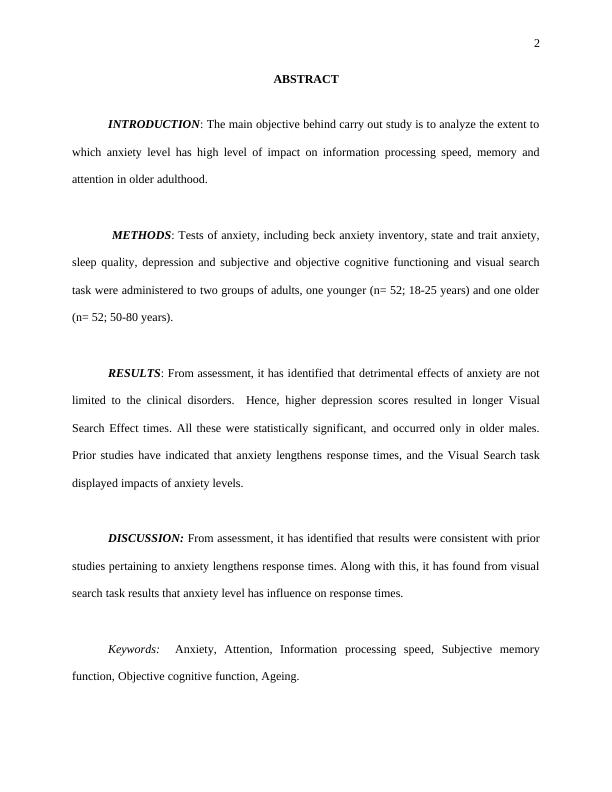
3IntroductionMild cognitive impairment implies for the situation of abnormality that is higher ascompared to expected aspects pertaining to age and education. From assessment, it has foundthat situation of self-perceived cognitive decline pertaining to memory aspect usually occurredamong older adults having both MCI and dementia at early stage. Along with this, it has foundthat memory function closely influences daily life and mental health of individual. In bothcognitively healthy ageing and ageing–related diseases states such as Alzheimer’s disease, alarge body of evidence supports an association between information processing speed and thefunctional integrity of both cognitive and of neuroanatomical aspects of the mind. These impactsinclude changes to the brain’s white matter, and alterations to components of informationprocessing system (Anstey et al., 2007; Haynes et al., 2017; Kennedy et al., 2013; Lövdén, Shing& Lindberger, 2007; Voelker et al., 2017). Neuroanatomical studies have identified age-relateddifferences in the interhemispheric data transfer rates and activation as well as differences inwhite matter integrity, with older adults demonstrating greater transfer rates than younger ones,possibly as a compensatory strategy to overcome ageing-related cognitive declines (Anstey et al.,2007; Haynes et al., 2017). These differences are identifiable using reaction time tasks asfundamental measures of both interhemispheric transfer and cognitive changes due to ageing(Antsey et al., 2007).As defined in the American Psychiatric Association’s (APA’s) Diagnostic and StatisticalManual of Mental Disorders (DSM-5) mild cognitive impairment (MCI) occurs when anindividual experiences memory and other core brain functions problems that do not interferewith independent living and which are not due to delirium or another mental disorder (APA,
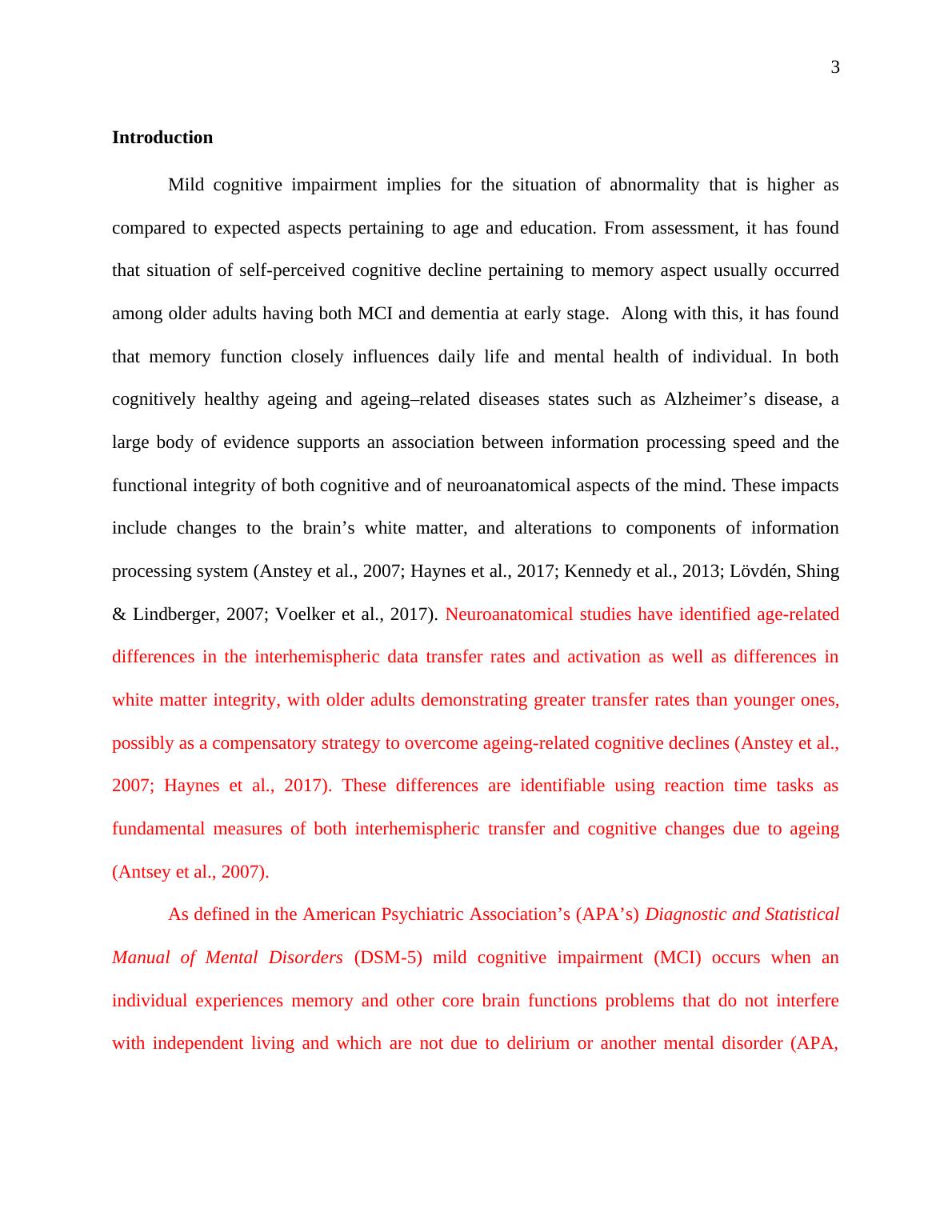
42013). Brain studies of individuals with MCI demonstrate that as many as 10 to 15 percent ofthose with MCI develop full dementia within a year (Fauzan & Amran, 2015).Information processing speed is commonly measured as part of the diagnosis of dementiaand cognitive impairment. In normal aging, the brain functions slow while intelligence measuresstabilise, and recall ability decreases significantly. Research evidence indicates that informationprocessing speed can vary significantly with respect to methodological factors such as the taskused and thus areas of the brain recruited for performance and response demands (Rodrigues &Pandeirada, 2014; Valeriani et al., 2003) and person-related factors such as sex (Commmodari &Guanera, 2013), education (Tales & Basoudan, 2016), and possibly genetic factors (Luo et al.,2017). Interactions between these factors can result in significantly different impacts onprocessing speeds depending on specific brain areas required for performance of tasks (Tales etal., 2010; Tales & Basoudan, 2016). Hence, older individuals often experience greater difficultyremembering the name of people, places and other aspects. Mild cognitive impairment (MCI)occurs when the individual experiences measureable problems in relation to memory and anothercore brain functions. MCI is also associated with increased risk of developing Alzheimer’sdisease in the short term. RT variability is impacted by a combination of three physiological effects: hemisphericspecialization, individual neuroanatomy, and transient functional fluctuations between trials(Antonova et al., 2016), Thus, RT measures need to consider many aspects of typical behaviorand environmental interaction (Rodrigues & Pandeirada, 2014, Tales & Basoudan, 2016).Results of information processing speed tests in clinical populations may need to be interpretedwith respect to such caveats, making it difficult to relate clinical to research findings.It isincluded in DSM-5 for measurement specifically with respect to attention-related processing
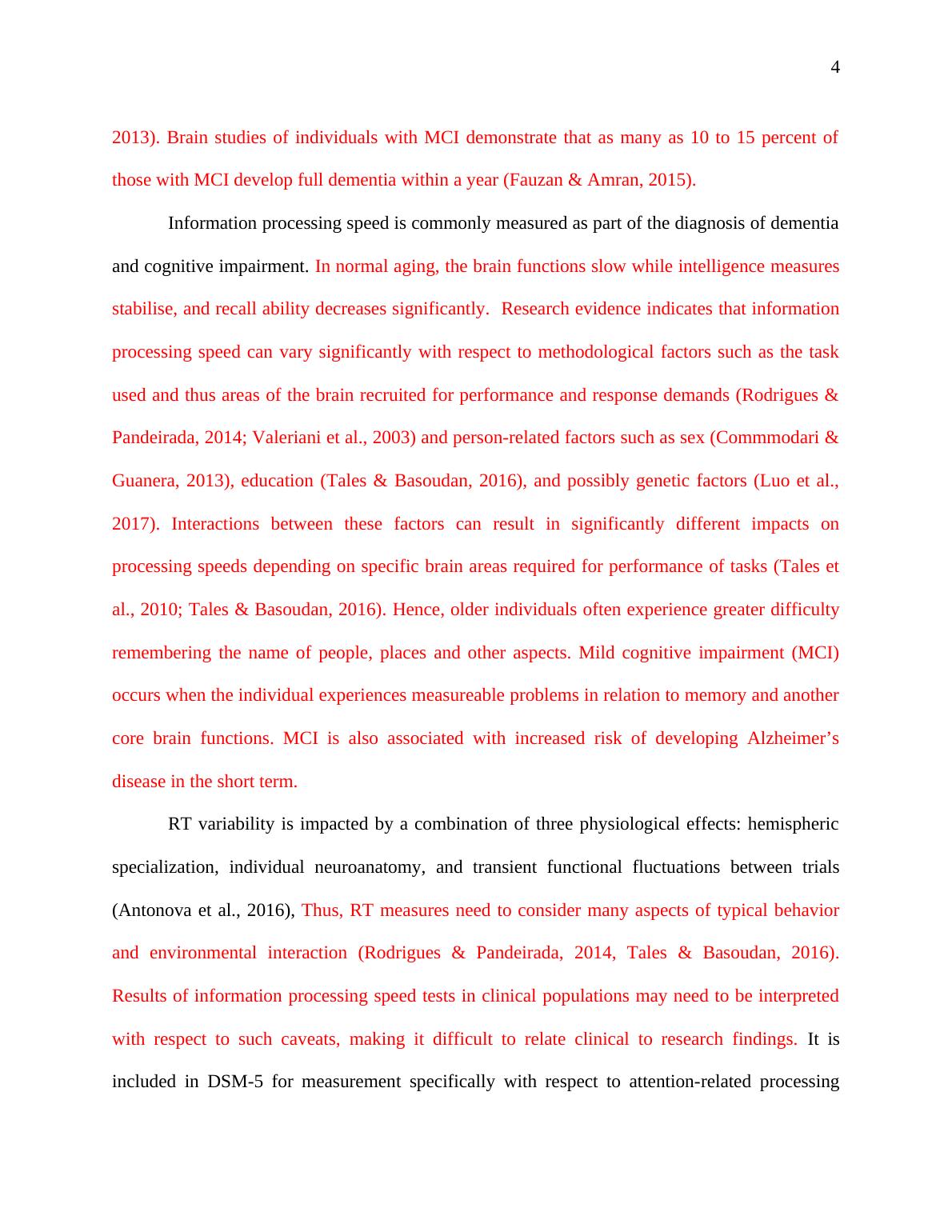
5(Naveteur et.al., 2005). Research indicates that information processing speed can varysignificantly with respect to methodological factors such as the task used and thus areas of thebrain recruited for performance and response demands and person-related factors such as sex andeducational level (Tales, Bayer, Haworth & Snowden, 2010). Such research evidence indicatesthat the results of information processing speed tests in clinical populations may need to beinterpreted with respect to such caveats, especially as there is a high degree in variability in thetasks used to measure information processing speeds in clinical populations, making thecomparison of results within the clinical arena problematic and also making it difficult to relateclinical to research findings. It is important to measure information processing speed because slowing of informationprocessing can have a negative influence upon many aspects of real life [Increased RT in olderadults has been shown to be associated to increased antagonist muscle co-activation. In oldersubjects, the RTs for both measures were significantly longer than for younger adults (Arnold etal., 2015). From assessment, it has identified that three physiological effects namely hemisphericspecialization, individual neuroanatomy and transient functional fluctuations between trials hasan impact on RT variability (Antonova et al., 2016). Thus, RT measures need to be assessedappropriately and in relation to many aspects of typical behaviour and environmental interaction(Rodrigues & Pandeirada, 2014).By doing research, it has identified that risk of dementia can be reduced significantlythrough the means of resourcefulness training. From evaluation, it has asserted that RT trainingprovides high level of assistance in reducing the level of caregiver stress. It is possible that otherfactors that are rarely researched and rarely tested in clinical conditions, may also affectinformation processing speed. One such factor is anxiety. Salthouse (2011) highlighted the
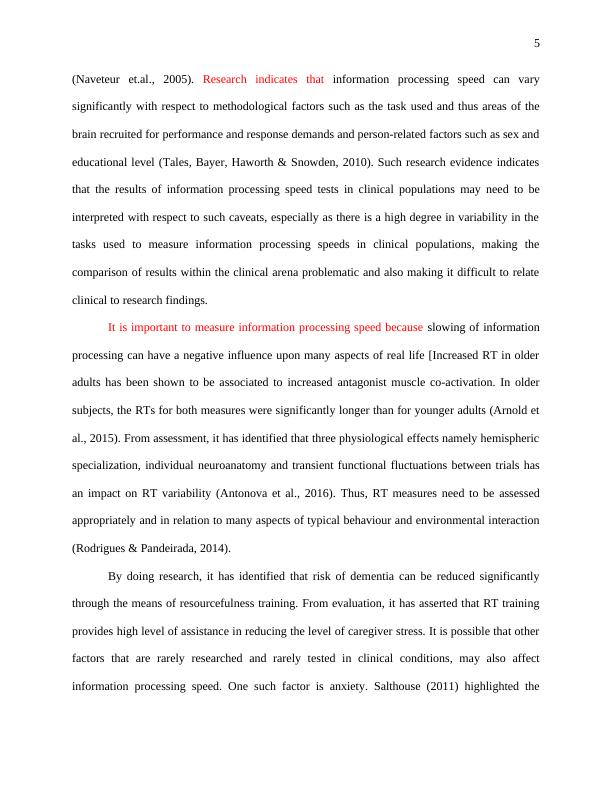
6possibility that anxiety may affect RT performance and that although high levels of clinicalanxiety may be acknowledged to affect information processing speeds, lower levels of anxietyare generally not considered to have any effect. In contrast, however, Tales and Basoudan (2016)noted that anxiety has a high prevalence in older adults and that even non-clinical anxiety mayimpact cognitive performance. One aim of this research is to determine the potential for anxietyto affect the outcome of information processing speed in older adults.Subjective Cognitive FunctionAnother factor that has rarely been considered in the investigation of informationprocessing speed in ageing and ageing-related disease is subjective cognitive function. Althoughmost studies examining information processing speed in ageing measure and factor in thepotential influence of objectively measured status of cognitive function it is rare for researchresults to consider how subjective feelings or assessment of cognitive function may influenceinformation processing speed. Objective measures of poor general cognition are often found tobe related to slower information processing speeds compared to intact cognition in older adults(Tales & Basoudan, 2016). It is possible that subjectively poor cognition may also affectinformation processing speed (either via similar or different mechanisms as yet to be fullyidentified). If this is the case then both clinical and research findings would need to be interpretedwith respect to this caveat also. A further aim of this study is also to determine whether in olderadults either objectively measured or subjectively experienced cognitive function influencesinformation processing speed. Finally, the potential influence of sex (male/female) andeducational level upon information processing speed will also be investigated.

7Intra-Individual VariabilityIn the research arena in addition to measuring information processing speed it has beencommon to measure also its intra-individual variability (IIVRT). IIVRT like information processingspeed is also related to cognitive and neuroanatomical factors, with increased variabilitycommonly but not always, related to disease related ageing such as Alzheimer’s disease, and insome cases, has been found to be more sensitive to ageing and or disease than mean informationprocessing speed per se (Luo et al., 2017; Tales & Basoudan, 2016). Although previous researchhas examined IIVRT with respect to objectively measured cognitive function very little researchhas examined the influence of subjective cognitive function and anxiety. This measure will thusalso be investigated in the present also be investigated in the present study considering genderand level of education.AttentionAttention is one of the cognitive functions most affected by ageing. The loss of functionin attention can impact a wide variety of cognitive activities and daily living functions (Akimotoet al., 2014). Valeriani, Ranghi and Giaquinto (2003) identified differences in somatosensoryevoked potentials (SEPs) to median nerve stimulation between tasks requiring neutralstimulation conditions and selective attention conditions for both older (mean age 71.7) andyounger (mean age 26.9) adults and abnormal attention function found in MCI and variousaetiologies of dementia (Tales, Bayer, Haworth & Snowden, 2010). Of particular context for thecurrent study is the demand by DSM-5 that information processing speed should be measuredwith respect to attentional function. In this study, therefore, these questions are investigated

8using a computer-based visual search task which allows measurement of attention-related choicereaction time and attentional function (Therrien & Hunsley, 2011).AnxietyAnxiety prevalence and levels vary with respect to age and age-related conditions such assubjective and objective cognitive impairment, and Alzheimer’s disease (AD). Estimates varyfrom 1 to 28% depending on whether clinical or community-dwelling populations are used(Bryant et al., 2008; Therrien & Hunsley, 2011; Wolitzky-Taylor, et al., 2010).Anxiety alsoimpact visuals search tasks, with generalized anxiety disorder patients showing slower RTs, butnot enhanced detection of threats (Rinck et al., 2003). There exists, however, a paucity ofevidence regarding the potential influence anxiety, especially non-clinical anxiety, may haveupon research outcome and therefore potentially clinical results and interpretation. Evidenceexists that associates anxiety with the ventral prefrontal cortex and the amygdala. These twoareas of the brain have greater activation in anxious situations as they are the main activationsector to responses accorded by the brain (Guyer et al, 2008). Anxiety brings about an increase instimulus-driven processes that negatively impact efficient top-down control and consequentlyhave a detrimental effect on the ability to regulate emotional inhibitions (Ansari & Derakshan,2011). Anxiety also impact visuals search tasks, with generalized anxiety disorder patientsshowing slower RTs, but not demonstrating enhanced detection of threats (Rinck et al., 2003).Dennis, Scialfa and Ho (2004) found that older adults were no more reliant on bottom-up vs. top-down learning in visual search tasks compared to younger adults, and were no more susceptibleto distractions.
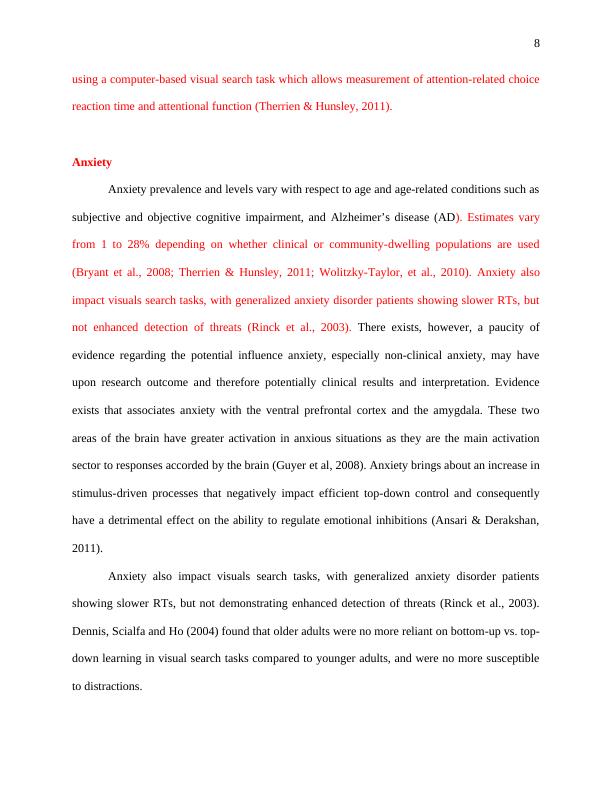
End of preview
Want to access all the pages? Upload your documents or become a member.
Related Documents
Visual Search and Information Processing Speedlg...
|46
|13333
|304
Anxiety, Reaction Time, and the Variability of Reaction Time in Younger and Older Adultslg...
|91
|11426
|49
(PDF) Anxiety disorders in older adultslg...
|34
|9370
|58
Subjective And Objective Cognitive Impairment : Literature Reviewlg...
|60
|18572
|66
Difference in Non-Clinical Anxiety Levels between Young and Older Adults and in Respect to Depression, Cognitive Functions and Demographic Parameterslg...
|34
|10472
|446
Effects of Sub-clinical Anxiety Levelslg...
|39
|8262
|18
